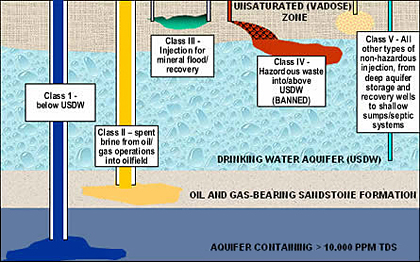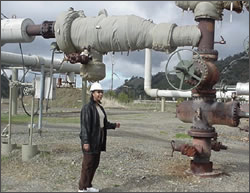Contact EPA Pacific Southwest Groundwater
Pacific Southwest, Region 9
Serving: Arizona, California, Hawaii, Nevada, Pacific Islands, Tribal Nations
Underground Injection Control (UIC)
| Underground Injection Control (UIC) Quick Finder | ||
|---|---|---|
| Ground Water HomeUIC Home | Cesspools in HawaiiClass V Wells | UIC PermitsOnsite Sewage Treatment |
National Links
Resources
Potential sources of ground water contamination are numerous. Injection wells, which carry and permanently place fluids underground, are a potential ground water contamination source if not properly sited, constructed and maintained. See EPA's National UIC site for an in-depth description of the underground injection control program. Injection wells are regulated by the EPA under the authority of the Underground Injection Control (UIC) program, as provided for by Part C of the Safe Drinking Water Act. Federal Underground Injection Control regulations are located at 40 CFR parts 144-147.
The UIC Program regulates the subsurface injection of waste fluids below, into and above underground sources of drinking water (USDWs). "Injection" includes seeping, flowing, leaching, and pumping, with or without added pressure. A USDW is defined as any ground water containing 10,000 milligrams per liter or less of total dissolved solids, in a quantity that can sustain a public water supply system (minimum 15 connections or 25 persons). The UIC program defines five classes of wells according to the type of fluid they inject and where the fluid is injected. For more information, see the Underground Injection Control regulations beginning at 40 CFR part 144.

State UIC programs in the Pacific Southwest (EPA Region 9) are fully delegated to Nevada, Guam, and the Commonwealth of Northern Mariana Islands. Partial delegation has been granted to the Navajo Nation for Class II wells and the California Division of Oil, Gas, and Geothermal Resources for Class II wells and for regulation of geothermal injection in the state. In non-delegated state and tribal areas, including Hawaii, Arizona, California, and the Navajo Nation as well as more than 145 federally recognized tribes, EPA directly implements the UIC program with support from state and tribal water quality agencies. ![]()
Additional UIC Topics

Classes of Wells
EPA defines the five classes of wells according to the type of fluid they inject and where the fluid is injected.
Final Rulemaking for the Navajo Nation Class II Underground Injection Control Program
California Division of Oil, Gas and Geothermal Resources Class II UIC Program Review (PDF) (490 pp, 11M large file, About PDF)
In Spring 2010, EPA undertook a comprehensive review of California’s implementation of the Class II UIC primacy program. The goals of this program evaluation were to review how the California Division of Oil, Gas and Geothermal Resources (DOGGR) oversees and manages the permitting, drilling, operation, maintenance and plugging/abandonment of Class II wells in the State, and identify program implementation recommendations. Attached is the final report (PDF) (490 pp, 11M large file) dated June 2011.
Register Injection Wells
Register any class of injection well using this online inventory form.
Class V Wells
Shallow injection wells, known as Class V Wells, are among the greatest threats to the quality of underground sources of drinking water.
Cesspools in Hawaii
EPA regulations require the closure of all large capacity cesspools by April 5, 2005
Onsite Sewage Treatment
Septic systems and more advanced onsite wastewater treatment technologies rely on soil to complete treatment of sewage and sanitary wastewater before dispersing it into the environment.
